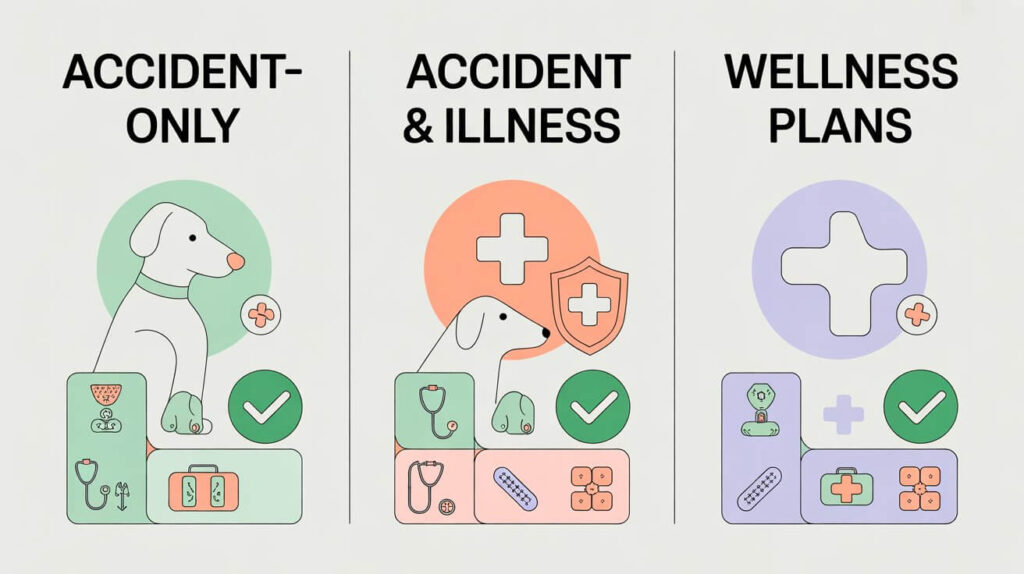Does Pet Insurance Cover Spaying? A Complete 2025 Guide for Pet Owners
If you’ve recently adopted a cat or dog, spaying (or neutering) is one of the most responsible decisions you can make for your furry friend’s health.
But here’s the catch—spaying surgery can be costly. So, the question many pet owners ask is: “Does pet insurance cover spaying?”
In this in-depth 2025 guide, we’ll break down how pet insurance works when it comes to spaying, what types of coverage you can expect,
and how to make the procedure more affordable without sacrificing your pet’s care.
🐾 What Is Spaying and Why It Matters

Spaying is a surgical procedure that removes a female pet’s ovaries and uterus to prevent pregnancy. The male equivalent is neutering, which removes the testes.
Veterinarians and organizations like the ASPCA and RSPCA recommend these surgeries because they:
- Prevent unwanted litters
- Reduce the risk of certain cancers (e.g., ovarian, uterine, and testicular)
- Decrease behavioral issues like aggression and roaming
- Contribute to longer, healthier lives
But while the benefits are clear, the average cost of spaying in the U.S. can range from $200 to $500, depending on your pet’s size, age, and where you live. That’s why understanding whether pet insurance covers spaying can save you hundreds of dollars.
💡 Quick Answer: Does Pet Insurance Cover Spaying?

Standard pet insurance does NOT cover spaying or neutering.
Most pet insurance plans only cover unexpected accidents and illnesses—not routine or elective procedures. Since spaying is considered a preventive or elective surgery, it usually falls outside basic coverage.
However, there’s good news:
👉 Some pet insurance companies offer wellness or preventive care add-ons that do include spaying and neutering costs.
Let’s explore that next.
🧾 How Pet Insurance Works (and Why Spaying Isn’t Usually Included)
To understand why spaying isn’t typically covered, you first need to know what pet insurance is designed for.
1. Accident-Only Plans
These are the most affordable but most limited. They cover injuries from accidents (like broken bones or ingestion of foreign objects).
➡ Does it cover spaying? ❌ No
2. Accident & Illness Plans
These are the most popular. They cover illnesses like cancer, infections, and chronic diseases, plus accidents.
➡ Does it cover spaying? ❌ No (spaying isn’t an illness or emergency)
3. Wellness or Preventive Care Add-Ons
These optional plans are designed for routine care—think vaccinations, dental cleanings, and annual exams.
➡ Does it cover spaying? ✅ Yes, in some cases
In short:
If you want your pet’s spaying to be covered, you’ll need to purchase a wellness plan or add-on.
🩺 Pet Insurance Companies That Cover Spaying
Here’s a look at some well-known pet insurance providers that may cover spaying through wellness packages:
| Insurance Company | Spaying Coverage | How It Works |
|---|---|---|
| Healthy Paws | ❌ No | Focuses on accidents & illnesses only. |
| Trupanion | ❌ No | Doesn’t offer wellness or preventive coverage. |
| Nationwide | ✅ Yes | Includes spay/neuter in their “Whole Pet with Wellness” plan. |
| ASPCA Pet Health Insurance | ✅ Yes | Offers wellness add-ons that include spaying. |
| Embrace Pet Insurance | ✅ Yes | Has a “Wellness Rewards” program for routine care. |
| Fetch by The Dodo | ❌ No | Covers accidents and illnesses only. |
| Spot Pet Insurance | ✅ Optional | Offers preventive care packages that include spay/neuter. |
💡 Tip: Always read the fine print before signing up. Some plans only reimburse a fixed amount (e.g., $150–$250) for spay/neuter surgery.
🧬 Why Spaying Is Considered a Preventive (Not Emergency) Procedure
Spaying is usually scheduled when the pet is healthy, not due to illness or injury.
Because it’s preventive, it’s grouped with other routine care procedures, like:
- Microchipping
- Deworming
- Dental cleanings
- Vaccinations
Insurance companies exclude these to keep premiums lower for the majority of pet owners who might not need them every year.
However, if complications arise during a spay surgery—say, your pet reacts poorly to anesthesia—those medical complications could be covered under your main accident/illness policy.
💰 Average Cost of Spaying in the U.S. and U.K.
| Country | Low-Cost Clinics | Private Vet Clinics | Average Cost |
|---|---|---|---|
| USA | $100–$200 | $300–$500 | ~$300 |
| UK | £80–£150 | £200–£400 | ~£250 |
📍Example: In California or New York, large-breed dogs may cost up to $600+ due to anesthesia and recovery expenses.
These costs can vary depending on:
- Your pet’s weight and age
- The clinic or hospital you choose
- Whether your pet is in heat or pregnant at the time of surgery
🧠 How to Save Money on Spaying Without Insurance
If your insurance doesn’t cover spaying, don’t worry—there are plenty of ways to make it more affordable.
1. Use Low-Cost Spay/Neuter Clinics
Organizations like ASPCA Spay/Neuter Alliance and local humane societies often offer discounted surgeries.
2. Check for Local Vouchers or Government Programs
Some cities and counties run subsidized programs for low-income pet owners.
3. Adopt from a Shelter That Covers Spaying
Most shelters spay or neuter pets before adoption, saving you the full cost.
4. Look Into Payment Plans or CareCredit
Some veterinarians allow monthly payments or accept CareCredit (a healthcare credit card).
5. Bundle Spaying With Other Wellness Services
When you book vaccines or microchipping together with spaying, many clinics offer package discounts.
🐶 Real Example: How a Wellness Add-On Helps
Case Study:
Samantha, a pet owner from Chicago, bought a Nationwide “Whole Pet with Wellness” plan for her 6-month-old Labrador puppy.
Here’s what she paid and received:
- Premium: $60/month
- Annual reimbursement limit: $250 for spay surgery
- Actual vet cost: $420
- Reimbursed amount: $250
Savings: $250 reimbursed, plus additional coverage for vaccines and dental cleaning.
This type of wellness coverage is ideal if you want predictable yearly vet costs and a healthier pet overall.
📘 What to Ask Your Pet Insurance Company Before You Buy
Before signing up for pet insurance, ask these critical questions:
- Does your plan offer wellness or preventive care add-ons?
- What’s the maximum reimbursement for spaying?
- Is there a waiting period before coverage begins?
- Can you combine wellness with accident/illness coverage?
- Does the plan cover complications from spay surgery?
Getting clear answers ensures you don’t face unexpected bills later.
⚖️ Spaying vs. Not Spaying: The Cost of Waiting
While paying out-of-pocket for spaying may seem expensive upfront, not spaying can lead to much higher costs down the road.
Potential risks of not spaying your pet:
- Pyometra (uterine infection) — emergency surgery can cost $1,000–$2,000+
- Increased cancer risk — treatment can cost several thousand dollars
- Unwanted litters — added expenses for care and adoption
💬 Expert Tip: According to the PetMD, spaying a female dog before her first heat can reduce the risk of mammary tumors by up to 90%.
So even if insurance doesn’t cover the cost, spaying is an investment in your pet’s long-term health and your financial peace of mind.
🧾 Pros and Cons of Wellness Plans That Cover Spaying
| Pros | Cons |
|---|---|
| Covers routine care like vaccines, dental, and spay/neuter | Higher monthly premiums |
| Helps manage predictable vet costs | May reimburse only partial cost |
| Encourages preventive health care | Some plans have annual caps |
| Peace of mind for new pet owners | Not all states or countries offer them |
🐾 How to Choose the Right Coverage
When comparing pet insurance policies:
- Start with your pet’s age and breed. Younger pets benefit more from wellness add-ons.
- Calculate the annual cost of preventive care (vaccines, exams, spaying).
- Compare it with the cost of the wellness add-on. If the reimbursement outweighs the premium, it’s worth it.
- Read reviews from trusted sources like Forbes Advisor or NerdWallet to ensure reliability.
💬 Frequently Asked Questions
❓ Does Pet Insurance Cover spaying after an accident?
Only if the spaying becomes medically necessary due to an illness or injury. For example, if your vet recommends removing reproductive organs due to infection, it may be covered.
❓ Can I buy a wellness plan after I’ve already insured my pet?
Yes, many insurers let you add wellness coverage later, but some require you to do so at policy renewal.
❓ Are male pets (neutering) covered the same way?
Yes. Spaying (female) and neutering (male) are treated equally under wellness add-ons.
❓ Is spaying required for insurance eligibility?
Not usually, but some policies offer discounts for spayed/neutered pets since they are less likely to develop certain health issues.
🐕 Final Thoughts: Should You Get Pet Insurance That Covers Spaying?

If you want comprehensive protection and plan to keep your pet’s health a top priority, investing in a pet insurance policy with wellness coverage is a smart move.
Even though basic pet insurance doesn’t cover spaying, adding a wellness plan can help offset costs for spaying, vaccines, and annual exams—all of which contribute to a healthier, happier pet.
Pingback: Best Pet Insurance MA Guide 2025: Top Plans & Coverage Explained Best Pet Insurance MA Guide 2025: Top Plans & Coverage Explained